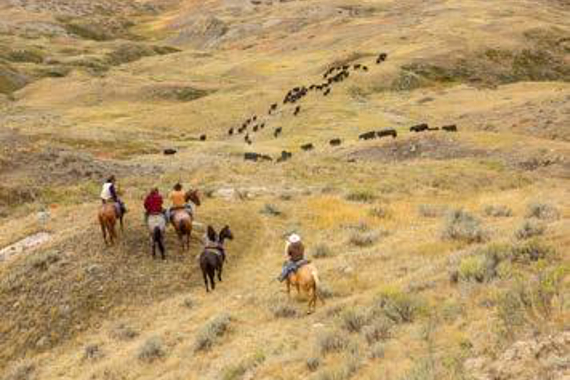
A volunteer adds plastic tags to a fence to increase visibility and reduce wildlife collisions by species like the greater sage-grouse. Photo: © L. Gardiner
Preserving prairie icons
Recovering species at risk in Grasslands National ParkFootnote *
What’s the issue?

Temperate grasslands are the most endangered biome on the planet. In Canada, about 70 percent of native prairie has been lost – mainly due to agriculture and oil and gas development. Throughout Grasslands National Park, established to protect mixed-grass prairie, ecosystem restoration efforts are aimed at reducing a legacy of threats that began before the park was established. These include invasion by non-native plant species (like leafy spurge), loss of characteristic species (like black-footed ferret), and the elimination of key ecological processes (like fire). While restoring the park helps the recovery of species at risk – greater short-horned lizard, burrowing owl, swift fox – it can also reconnect Indigenous peoples to the prairie landscape and strengthen the conservation ethic in park visitors and Canadians generally.
What’s our approach?
- Manage the reintroduced plains bison herd size at a sustainable level (300–500 individuals).
- Plant or seed up to 75 hectares of silver sagebrush, nesting and feeding habitat for greater sage-grouse.
- Improve habitat quality in black-tailed prairie dog colonies by mowing or grazing, and replanting native species.
- Generally increase habitat availability for multiple species at risk by igniting prescribed fires over 400 hectares of grassland.
- Reduce the risk of wildlife collisions by removing fences or marking them to increase visibility.
- Engage Canadians in mixed-grass prairie conservation by building new, and improving existing park infrastructure, enhancing programing and reaching out with traditional and social media.
What’s been accomplished?
- Maintained bison numbers at a herd size within the sustainable target each year.
- Planted and seeded over 42 hectares of silver sagebrush in 2016 and 2017.
- Applied prescribed fire to 106 hectares in 2015 and 13 hectares in 2016 to reduce invasive leafy spurge, smooth brome and crested wheatgrass, and to an additional 137 hectares in 2016 to create new black-tailed prairie dog habitat.
- Removed or marked 93 km of fencing (2015–2017), reducing the likelihood of wildlife collisions.
- Raised public awareness about mixed-grass prairie conservation by increasing visitor engagement by 55 percent, creating three new volunteer programs, publishing nine media stories and increasing Facebook likes by 34 percent.
- Date modified :